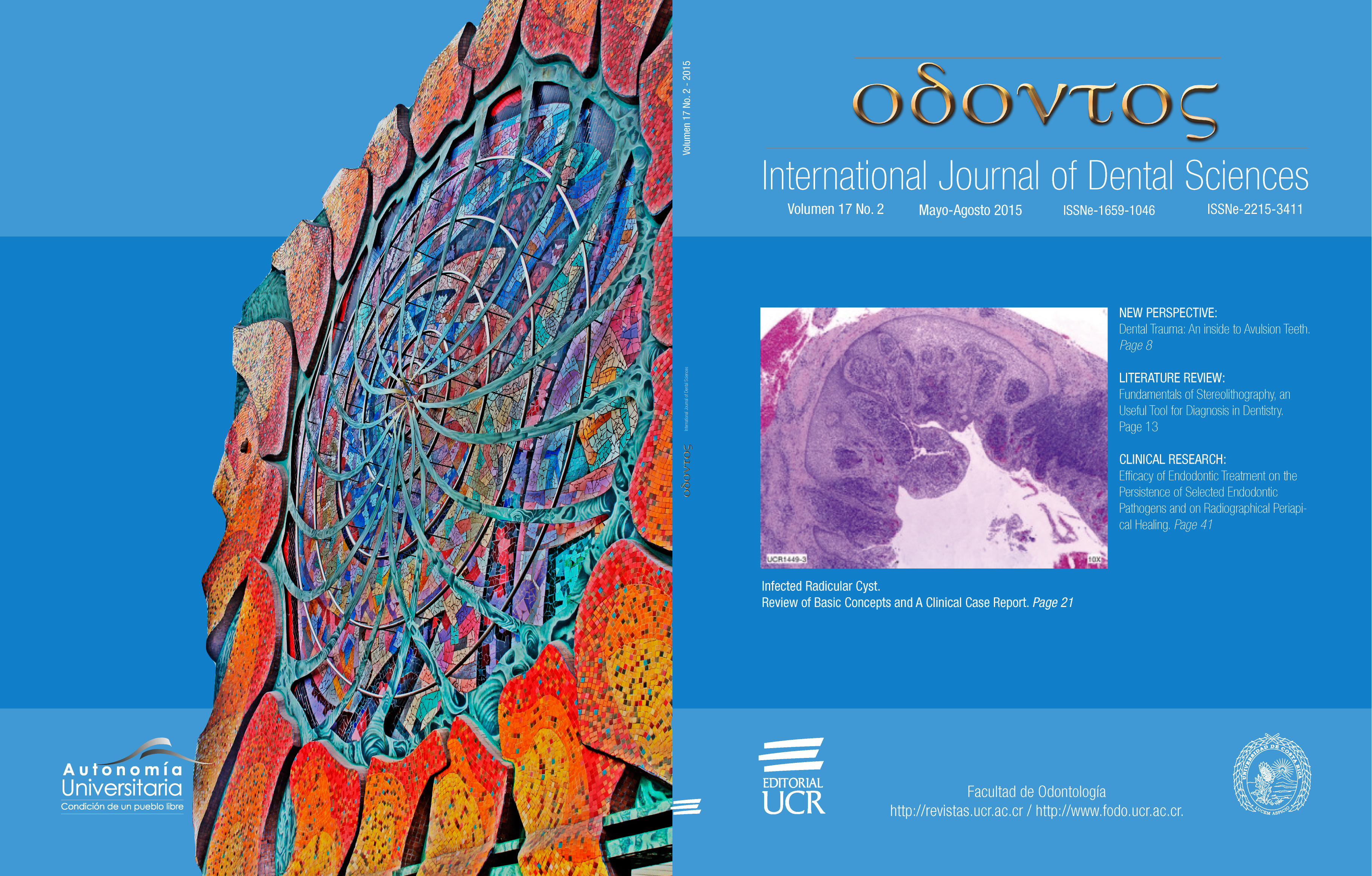Resumen
Los avances en la tecnología digital e imagenología en los pasados 25 años han permitido la implementación de protocolos de modelado en tercera dimensión (3D) en Odontología. El uso de modelos estereolitográficos han remplazado progresivamente a los modelos y rayos X en el manejo de anomalías craneofaciales y en la rehabilitación con implantes. Diversas ventajas pueden ser mencionadas, incluyendo mejor visualización de estructuras anatómicas complejas y más preciso y sofisticado plan prequirúrgico a través de una vista simulada del procedimiento de interés. El objetivo de esta revisión es brindar información básica sobre las aplicaciones y limitaciones de la estereolitografía, dirigida a aquellos dentistas generales y estudiantes de odontología interesados en obtener experiencia en las áreas de cirugía reconstructiva e implantología
Citas
Ayoub, A.F., Rehab, M., O’Neil, B., Chambray, X., Ju, X., Barbenel, J., & Naudi, K. (2014). A novel approach for planning orthognathic surgery: the integration of dental casts into three-dimensional printed mandibular models. InternationalJournal of Oral and Maxillofacial Surgery, 43: 454-459.
Balshi, S.F., Wolfinger, G.J., & Balshi, T.J. (2006). Surgical planning and prosthesis construction using computed tomography, CAD/CAM technology, and the Internet for immediate loading of dental implants. Journal of Esthetic and Restorative Dentistry, 18: 312-325.
Bártolo, P.J., & Gibson, I. History of stereolithographic processes. In: Stereolithography Materials, Processes and Applications. Bártolo PJ, Editor. Amsterdam, The Netherlands: Springer; 2011. pp. 42-49.
Casseta, M., Giansanti, M., Di Mambro, A., Calasso, S., & Barbato, E. (2013). Accuracy of two stereolithographic surgical templates: a Islas et al: Stereolithography, an Useful Tool for Diagnosis in Dentistry retrospective study. Clinical ImplantDentistry and Related Research, 15: 448-459.
Chia, H.N., & Wu, B.M. (2015). Recent advances in 3D printing of biomaterials. Journal of Biological Engineering, 9: 4-17.
Cohen, A., Laviv, A., Berman, P., Nashef, R., & Abu-Tair, J. (2009). Mandibular reconstruction using stereolithographic 3-dimensional printing modeling technology. Oral Surgery Oral Medicine Oral Pathology Oral Radiology, and Endodontology, 108: 661-666.
D’haese, J., Van De Velde, T., Komiyama, A., Hultin, M., & De Bruyn, H. (2012). Accuracy and complications using computer-designed stereolithographic surgical guides for oral rehabilitation by means of dental implants: a review of the literature. Clinical Implant Dentistry and Related Research, 14:321-335.
Dandekeri, S.S., Sowmya, M.K., & Bhandary, S. (2013). Stereolithographic surgical template:a review. Journal of Clinical and Diagnostic Research, 7: 2093-2095.
Ersoy, A.E., Turkyilmaz, I., Ozan, O., & McGlumphy, E.A. (2008). Reliability of implant placement with stereolithographic surgical guides generated from computed tomography: clinical data from 94 implants. Journal Periodontology, 79: 1339-1345.
Farley, N.E., Kennedy, K., McGlumphy, E.A., & Clelland, N. (2013). Split-mouth comparison of the accuracy of computer-generated and conventional surgical guides. The International Journal of Oral & Maxillofacial Implants, 28: 563-572.
Groth, C., Kravitz, N.D., Jones, P.E., Graham, J.W., & Redmond, W.R. (2014). Three-Dimensional printing technology.Journal of Clinical Orthodontics, 48: 475-484.
Malagón-Hidalgo, H., Wong-Romo, G., & Rivera-Estolano, R.T. (2009). Stereolithography: a method for planning the surgical correction of the hypertelorism. The Journal of Craniofacial Surgery, 20: 1473-1477.
Plooij, J.M., Maal, T.J., Haers, P., Borstlap, W.A., Kuijpers-Jagtman, A.M., & Bergé, S,J. (2011). Digital three-dimensional image fusion process for planning and evaluating orthodontics and orthognathic surgery: a systematic review. International Journal of Oral and Maxillofacial Surgery, 40: 341-352.
Sammartino, G., Della-Valle, A., Marenzi, G., Gervino, S., Martorelli, M., di Lauro, A.E., & di Lauro, F. (2004). Stereolithography in oral implantology: A comparison of surgical guides. Implant Dentistry, 13: 133-136.
Schendel, S.A., & Lane C. (2009). 3D Orthognathic surgery simulation using image fusion. Seminars in Orthodontics, 15: 48-56.
Terajima, M., Yanagita, N., Ozeki, K., Hoshino, Y., Mori, N., Goto, T.K., Tokumori, K., Aoki, Y., & Nakasima A. (2008). Three dimensional analysis system for orthognathic surgery patients with jaw deformities. American Journal of Orthodontics and Dentofacial Orthopedics, 134: 100-111.
Torabi, K. Farjood, E. & Hamedani, S. (2015). Rapid phototyping technologies and their applications in prosthodontics, a review of literature. Journal of Dentistry, Shiraz University of
Medical Sciences, 16: 1-9.
Turbush, S.K., & Turkyilmaz, I. (2012). Accuracy of three different types of stereolithographic surgical guide in implant placement: an in vitro study. Journal of Prosthetic Dentistry, 108: 181-188.
Winder, J., & Bibb, R. (2005). Medical rapid prototyping technologies: State of the art and current limitations for application in oral and maxillofacial surgery. Journal of Oral and Maxillofacial Surgery, 63: 1006-1015.

